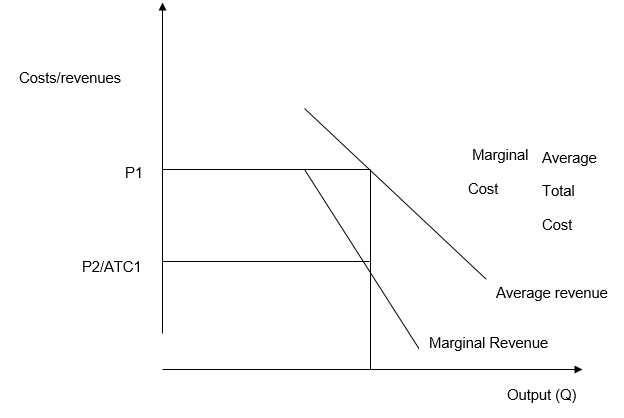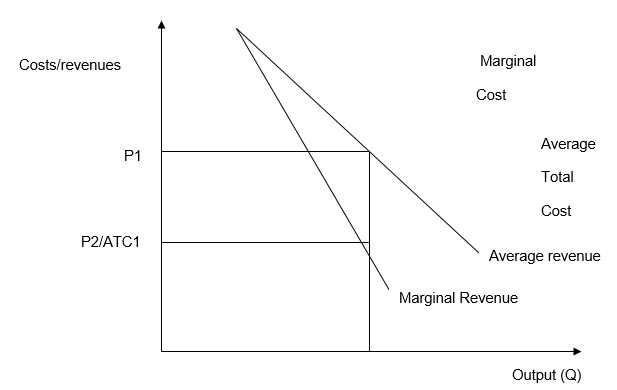Show on a diagram of the situation she faced in the period when her club initially took off. Indicate the sort of profits she would be making (it doesn’t have to show the exact figures).

The profits that she can make when operating on this sort of a monopoly curve are P1-P2. The prices that she can sell in the market are P1 and P2. At the price P2, other bars are charging the same price but because she has the only bar with comedians, she has been charging the price P1 for the past period. This has resulted in a supernormal profit as shown by the difference between P1 and P2. Because of the monopoly power she has she can set the profits higher than the rival bars so she can make more profits, (Goodwin, N.M., et al. 2008).
On another diagram, draw in the cost and revenue curves after the new club arrived. Label the profit-maximizing level of output.

With the entry of anew pub offering a similar but differentiated product in the market then the curve for the club belonging to Lucy Reynolds changes to that of monopolistic competition. In this kind of market situation, two firms offer the same product in the market but it is slightly differentiated. The operations in this model are that a recent monopoly will continue enjoying the supernormal profits in the short run. This is shown in the curve above.
After the entry of a new competitor in the market, Lucy Reynolds’ club will continue making profits by offering goods at price P1. This is high as compared to the costs incurred which are at P2/ATC1. In the long run, the club will be forced to adjust the prices they are offering in the short run. The adjustment will reduce the prices offered to P2 where the market operates, (Goodwin, N.M., et al., 2008).
Explain why the revenue curve has shifted and why she is no longer earning a supernormal profit.
This occurs in the long run after the entry of a new similar but differentiated competitor in the market. In the short-run equilibrium, the club has just come out of a monopoly situation. This means that the club maximizes its profits where the marginal revenue is equal to the marginal costs. In the short run before any adjustments, the firm collects the profits based on the average revenue curve, (Hirschery, M.D., 2000).
This situation changes in the long run after the adjustments of the curves due to changes in demand. The shift in the revenue curve is a result of the club still operating at the same marginal cost and marginal revenue as before. However, the club cannot set its prices depending on the average revenue curve due to the decrease in demand.
In the monopolistic situation, the products are differentiated by a small fact so the firms capitalize on this to earn abnormal profits in the short run. The clubs become monopolistic competitors and so they will both earn normal profits in the long run. The changes from the short run to a long-run scenario can result from the entry of new firms or an increase in production costs (Perloff, M.K., 2008). The entry of competing firms reduces the demand for goods in Lucy’s club by moving to the new club.
Both clubs in the long run split the demand hence no club will make an abnormal profit in the long run. If a firm can effectively utilize the short-run profitability then they can maintain it for a longer period by reducing the prices offered if a perceived threat is seen to emerge. This strategy efficiently employs the allocation of resources. This strategy will see the firm remain in profitability and also minimize its average costs. (Richards, F.R.,1998).
What advice would you give her if she began to show a loss? Under what conditions would you suggest she close down and leave town?
In such a scenario as Lucy is in then the market forces present inefficiency in allocation and productivity from resources employed. In many cases, such firms do not have a chance to fully exploit their fixed resources. This presents the inefficiency in production both in the short run and long run, (Wells, K.R., 2009). Due to this exploitation of opportunities then Lucy will start making losses due to the straining economic situations as well as the increased competition. She should close up shop after operating on a fixed profit for some time. To salvage the situation of closing up she should come up with advertising strategies.
Advertising is the best method for firms in the monopolistic competitive market to remain relevant. Advertising will enable her to create a brand name among her customers and probably bring some back to her club.
References
Goodwin, N.M., et al. (2008). Microeconomics in context, 3rd Edition. London: Sharpe.
Hirschery, M.D. (2000). Managerial Economics. New York: McGraw-Hill.
Perloff, M.K. (2008). Microeconomics Theory: Applications in Market Situations. New York: Pearson.
Richards, F.R. (1998). Microeconomics and Behavior, 7th Edition. London: McGraw-Hill.
Wells, K.R. (2009). Microeconomics, 2nd Edition. Washington DC: Anchor.